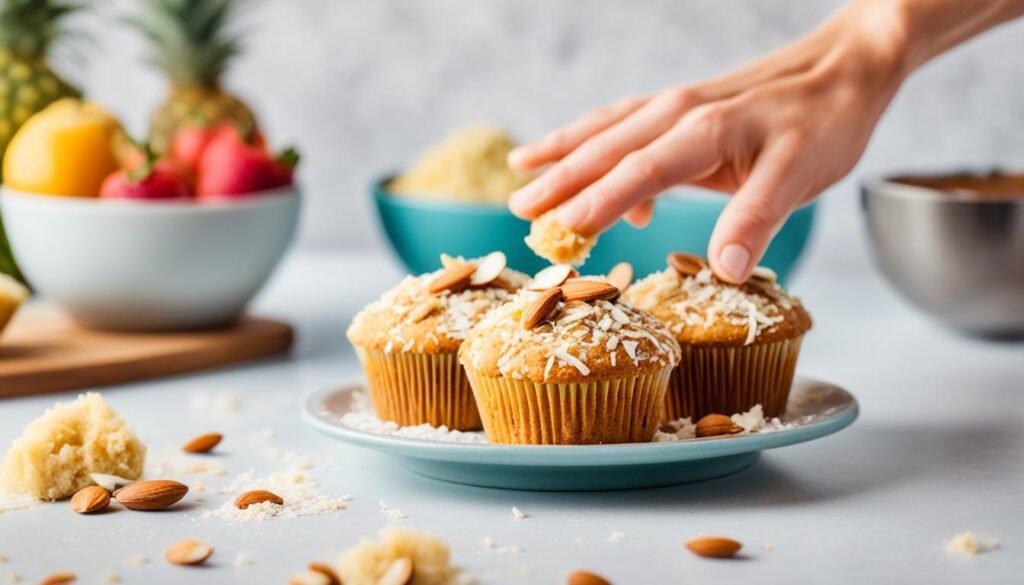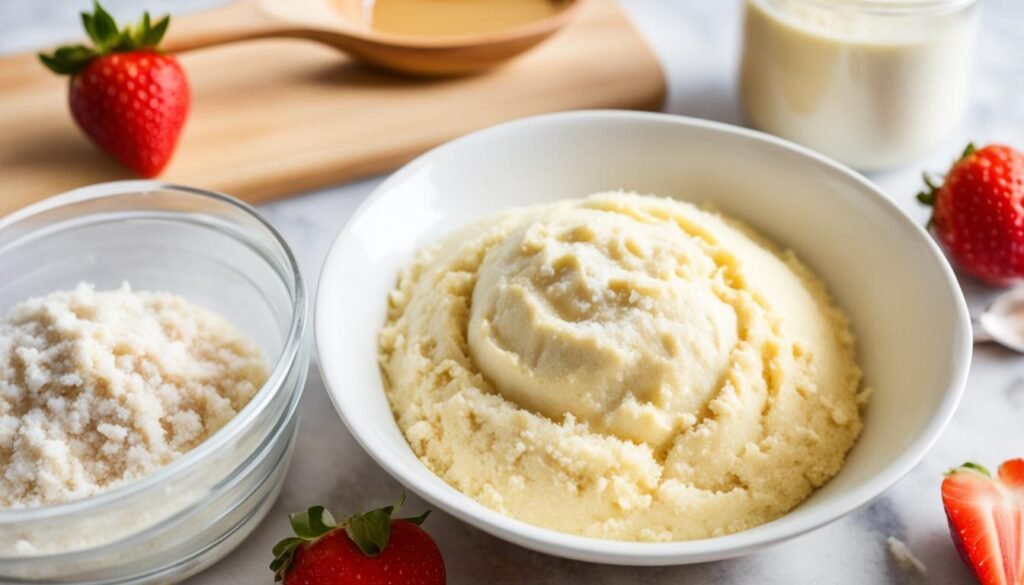If you’re looking for a nutritious snack that can fit seamlessly into your diet, Coconut Flour Muffins are the perfect solution. These delightful treats offer a wonderful option for those who prioritize healthy baking without sacrificing taste. Packed with flavor and made from gluten-free ingredients, these muffins cater to various dietary preferences, including low-carb muffins and paleo lifestyles.
The beauty of homemade muffins lies in their versatility and the joy of customizing them to fit your tastes. By utilizing coconut flour, you can create a moist and delicious muffin that satisfies your cravings while aligning with your health goals. Join us on this culinary adventure of baking gluten-free muffins that everyone will love, and discover how easy it is to enjoy wholesome snacks right from your kitchen.
Introduction to Coconut Flour Muffins
Coconut flour muffins have emerged as a delightful alternative in the world of baking, catering to those seeking healthier options. This ingredient is not just a substitute for traditional flour; it opens the door to a range of vibrant coconut flour recipes that are both nutritious and delicious. As more people embrace gluten-free lifestyles, the popularity of homemade muffins made with coconut flour continues to soar.
The unique properties of coconut flour make it an excellent choice for gluten-free muffins. It is highly absorbent, requiring less flour than other alternatives while delivering a rich, satisfying taste. Many bakers are discovering how versatile coconut flour can be, transforming simple ingredients into gourmet-style muffins that suit various dietary needs.
From banana coconut flour muffins to chocolate chip variations, there’s a recipe for everyone. These homemade muffins can easily be tailored to your preferences, appealing to those who enjoy sweet treats without compromising health. Discover the numerous benefits of incorporating coconut flour into your baking endeavors and join the trend of creating irresistible, gluten-free muffins that delight taste buds.
Benefits of Using Coconut Flour in Baking
Coconut flour offers a plethora of advantages for those venturing into healthy baking. Its impressive fiber content not only aids digestion but also promotes a satisfying sense of fullness, making it easier to resist unnecessary snacking. Many people appreciate these benefits, especially when preparing delicious coconut flour muffins.
One of the standout features of coconut flour is its low carbohydrate count. For individuals following a low-carb diet, this ingredient stands out by providing an alternative that aligns with their dietary goals. Switching to coconut flour helps in managing carbohydrate intake, making it a favorite among those seeking healthier options.
Beyond its fiber and carbohydrate profile, coconut flour is rich in essential vitamins and minerals. Ingredients like manganese, copper, and selenium contribute to overall wellness, enhancing the nutritional value of baked goods. Its nutritional profile makes it a compelling choice for anyone interested in grain-free baking.
Another significant advantage is its hypoallergenic nature. Coconut flour is suitable for people with gluten sensitivities or those following specific dietary restrictions. This quality allows for versatility in recipes, providing an inclusive ingredient for various dietary needs.

| Benefit | Description |
|---|---|
| High Fiber Content | Aids digestion and promotes fullness |
| Low Carbohydrate | Ideal for low-carb diets |
| Nutritional Profile | Rich in essential vitamins and minerals |
| Hypoallergenic | Suitable for gluten sensitivities and dietary restrictions |
Key Ingredients for Healthy Coconut Flour Muffins
Creating delicious coconut flour muffins requires understanding the special ingredients that contribute to their unique texture and flavor. The distinctive qualities of coconut flour enhance healthy baking, making it a fantastic gluten-free option. This section explores what makes coconut flour unique and provides guidance on selecting the right sweeteners.
What Makes Coconut Flour Unique?
Coconut flour stands out among various flours due to its *exceptional moisture absorption capabilities*. When using coconut flour for muffins, *consider that it requires additional liquid compared to traditional flours*. This quality means you’ll often need to adjust your recipe’s fluid requirements to achieve a suitable batter consistency. The high fiber content in coconut flour contributes not only to the *nutritional profile* but also helps maintain moisture, yielding a delightful bite in your gluten-free muffins.
Choosing the Right Sweetener
When selecting sweeteners for coconut flour muffins, aim for options that align with healthy baking principles. Natural sweeteners like *honey, maple syrup, or stevia* add a delicious flavor without compromising health goals. Each sweetener offers a unique taste profile, so experiment to find what best complements your vegan or gluten-free muffins. Consider the intensity of sweetness required for your recipe, as using various sweeteners can change the overall flavor balance in your baked goods.
Healthy Baking Techniques for Coconut Flour Muffins
Creating delicious gluten-free muffins with coconut flour requires a few specific techniques. Understanding the principles of healthy baking ensures a successful outcome, while also enhancing flavor and texture. This section includes essential tips for achieving the best results when baking with coconut flour.
Understanding Gluten-Free Baking
Gluten-free baking poses unique challenges due to the lack of gluten, which provides structure and elasticity in traditional recipes. Maintaining a good texture in gluten-free muffins involves:
- Utilizing ingredients that add moisture, such as eggs, yogurt, or applesauce.
- Integrating a binding agent, like flaxseed meal or chia seeds, to help hold the muffin together.
- Opting for a combination of gluten-free flours to improve texture, as coconut flour alone can be dense.
Tips for Perfect Texture
For optimal texture in your coconut flour recipes, consider the following:
- Adjust baking time to prevent dryness; coconut flour absorbs more moisture than other flours.
- Incorporate plenty of eggs to provide structure and moisture, essential for gluten-free muffins.
- Avoid overmixing to ensure your batter remains light and fluffy.

| Technique | Description | Benefits |
|---|---|---|
| Binding agents | Use flaxseed meal or chia seeds to bind ingredients. | Enhances structure in gluten-free muffins. |
| Moisture adjustment | Incorporate eggs, yogurt, or applesauce. | Prevents drying out and promotes fluffiness. |
| Mixing technique | Avoid overmixing the batter. | Keeps muffins light and airy. |
Delicious Coconut Flour Muffins Variations
Experimenting with variations of coconut flour muffins can elevate the flavor while keeping them healthy. By adding fruits and nuts, baking becomes an exciting adventure. Consider incorporating various spices for flavor enhancements. These modifications cater to different taste preferences while ensuring that your muffins remain low-carb and delicious.
Adding Fruits and Nuts
Fresh fruits can transform your coconut flour muffins into delightful treats. Popular choices include:
- Blueberries: Add a burst of sweetness and antioxidants.
- Bananas: Provide natural sweetness and moisture.
- Chopped apples: Introduce a crisp texture.
Nuts also play a crucial role. They not only enhance the taste but also add crunch. Try:
- Walnuts: Rich in omega-3 fatty acids.
- Almonds: A great source of protein and fiber.
Spice It Up – Flavor Enhancements
Adding spices can significantly alter the flavor profile of coconut flour muffins. Embrace the warmth of spices such as:
- Cinnamon: A classic option that pairs wonderfully with fruits.
- Vanilla extract: Brings depth and a comforting aroma.
- Cocoa powder: Perfect for a chocolatey twist.
How to Make Low-Carb Coconut Flour Muffins
Creating delicious low-carb coconut flour muffins is a rewarding endeavor for anyone looking to indulge without excessive carbs. Coconut flour serves as an ideal substitute for traditional flour, offering a gluten-free experience while maintaining a satisfying texture. Here are some essential tips to craft moist and flavorful low-carb muffins:
- Replace high-carb flours: Utilize coconut flour in place of conventional wheat flour. Coconut flour absorbs moisture differently, so a smaller quantity suffices.
- Adjust liquid ingredients: Since coconut flour is highly absorbent, increase the amount of eggs or liquids in your recipe to ensure your muffins remain fluffy.
- Choose appropriate sweeteners: Opt for low-carb alternatives like erythritol or stevia to maintain sweetness without the associated carbs.
- Incorporate healthy fats: Add ingredients like coconut oil or unsalted butter, which enhance flavor while providing a suitable fat balance in gluten-free muffins.
When it comes to baking techniques, pay attention to the oven temperature. For low-carb muffins, a consistent temperature aids in even baking. Consider using silicone muffin liners for easy removal and consistent moisture retention.
By applying these strategies, your low-carb coconut flour muffins will not only deliver flavor but also meet dietary goals. Enjoy a healthy snack that fuels your day without the guilt!
Paleo Muffins: A Grain-Free Option
Paleo muffins serve as an excellent choice for those who embrace grain-free baking while adhering to the principles of the paleo diet. This dietary lifestyle emphasizes whole, unprocessed foods, steering clear of grains, legumes, and dairy. Coconut flour muffins fit seamlessly within this framework, making them a delicious alternative that satisfies both taste and dietary requirements.
Utilizing coconut flour in healthy baking allows for a versatile approach to muffin making. The flour’s unique properties offer a high fiber content and healthy fats. To make paleo muffins, you can incorporate ingredients such as eggs, which provide moisture and structure, alongside natural sweeteners like honey or maple syrup. These ingredients are not only paleo-friendly but also add nutritional value to your baked goods.
Here are some compelling ingredients compatible with paleo principles for your muffins:
- Eggs
- Coconut oil
- Almond milk
- Raw honey
- Chia seeds
With a focus on wholesome ingredients, paleo muffins can cater to various tastes by adding fruits like blueberries or nuts such as walnuts. This flexibility allows for a wide range of flavors while maintaining adherence to healthy baking ideals.
| Ingredient | Paleo-Compatible | Health Benefits |
|---|---|---|
| Coconut Flour | Yes | High in fiber, low in carbs |
| Eggs | Yes | Rich in protein, healthy fats |
| Maple Syrup | Yes | Natural sweetener, retains nutrients |
| Almond Milk | Yes | Dairy-free, low-calorie alternative |
Incorporating coconut flour muffins into your paleo lifestyle can yield delightful treats that align perfectly with grain-free baking principles. These muffins not only please the palate but can also provide a nourishing addition to your diet.
Coconut Flour Muffins Recipe: Step-by-Step Instructions
Creating delicious coconut flour muffins is not only rewarding but also an enjoyable activity that promotes healthy baking. Start by gathering your ingredients: 1 cup of coconut flour, 4 eggs, 1/4 cup of coconut oil (melted), 1/2 cup of honey or maple syrup, and a pinch of salt. Preheat your oven to 350°F (175°C) and grease a muffin tin or line it with paper liners for easy removal.
In a large mixing bowl, combine the coconut flour and salt. In another bowl, whisk the eggs until frothy, then add in the melted coconut oil and honey (or maple syrup). Mix these wet ingredients well and then gradually stir them into the dry mixture until fully incorporated. The batter should be thick but easily spoonable. If you’d like to customize your coconut flour muffins, this is the time to add in some chocolate chips, chopped fruits, or nuts for an extra kick!
Pour the batter into the prepared muffin tin, filling each cup about 2/3 full. Bake for approximately 20-25 minutes, or until the tops are lightly golden and a toothpick inserted in the center comes out clean. Allow the muffins to cool for a few minutes before transferring them to a wire rack. Enjoy your homemade muffins as a wholesome snack or dessert, and get creative with variations that fit your tastes!